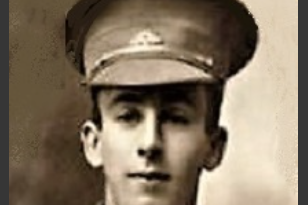General News
13 July, 2024
Veterans' Voices: Leslie Duncan Hutchins
- Sally Bertram, RSL Military History Library. Contact Sally at sj.bertram@hotmail.com or call 0409 351 940.

Leslie Duncan Hutchins was born at Natimuk (or Horsham, according to another record) on 4 May 1893.
His father was George Hutchins.
Leslie had enlisted in the Australian Navy on 7 November 1914 and served as an able seaman until 18 May 1915 serving at HMAS Cerberus at Williamston.
He decided instead to join the Australian Army, enlisting in the Australia Infantry Forces on 26 or 27 July 1915 as a 22-year-old single clerk. His Service Number was 4239.
He embarked from Melbourne Victoria on HMAT Demosthenes (A64) on 29 December with 8th Infantry Battalion, 13th Reinforcements.
On 22 February 1916 Private Hutchins was admitted to 1st Auxiliary at Heliopolis with influenza. He was discharged to duty on 29 February.
He was marched in and posted to Australian Reserve Brigade at Zeitoun on 2 March.
He joined 8th Battalion at Serapeum on 17 March from Reinforcements, and proceeded from Alexandria on 26 March on HMT Meganic to join the British Expeditionary Force (BEF).
He disembarked at Marseilles, France on 31 March.
On 8 Feb 1917 Private Hutchins reported sick and was admitted to 3rd Australia Field Ambulance, then transferred to 30 Casualty Clearing Station being admitted on 9 February.
He was taken to an Ambulance train on 14 February and from the train was admitted to 32nd Stationary Hospital on 15 February with appendicitis.
Private Hutchins was transferred to Boulogne and embarked for England on 21 February on the hospital Ship St David.
He was admitted to Voluntary Aid Temporary Hospital, Exeter, England, on 23 February with appendicitis which was considered slight. He was discharged to 2nd Auxiliary Hospital at Southall on 20 March.
Private Hutchins was discharged on furlo (leave) from 22 March to 6 April, and reported back to Perham Downs.
He was again admitted to hospital, this time to Anzac Hospital, Exeter on 28 March. He was transferred to 2nd Auxiliary Hospital on 25 May with appendicitis, leaving a “painful scar”.
Private Leslie Hutchins was discharged to an Army Depot at Weymouth on 21 June, and marched in to No 2 Command Depot at Weymouth, Dorset from 2nd Australian Auxiliary Hospital Southall.
He was then marched to No 3 Command Depot at Hurdcott, Wilshire on 29 June and was medically classified as being fit for overseas training camp.
On 25 July Private Hutchins was marched into overseas training depot, and proceeded overseas to France via Folkstone on 1 Australian Divisional Base Depot (ADBD) at Havre on 6 August.
He re-joined 8th Battalion in France on 21 August, and was on leave from France from 9 March to 28 March 1918.
He was appointed Lance Corporal from 20 April, but reported sick on 23 June. He was admitted to 2nd Australian Field Ambulance on 23 June, then transferred and admitted to 64 Casualty Clearing Station on 24 June.
Lance Corporal Hutchins was discharged to duty on 7 July and rejoined 8th Battalion on 9 July.
On 6 August he again reported sick. He was transferred to Ambulance Train 34 with a septic foot, and taken to 3rd Australian General Hospital at Abbeville on 7 August.
For a second time he was transferred to Boulogne and again embarked for England on 12 August on the hospital ship Stad Antwerpen with a septic right foot.
He was admitted to County of Middlesex War Hospital, Napsbury, St Albans, England on 12 August with what was diagnosed as slight septic foot.
Again, Leslie was transferred to 1 Auxiliary Hospital at Harefield on 20th August.
He was to go on leave from 20 August to 5 September, and from the conclusion of his leave reported to No1 Command Depot at Sutton Veny, Wiltshire, and was medically classified fit for duty in four weeks.
On 7 November he was march into overseas training Brigade at Longbridge Deverill, Wilshire.
On 25 November Lance Corporal Hutchins was again admitted to Group Clearing Hospital at Sutton Veny, Wiltshire with an intestinal obstruction.
He was transferred to Military Hospital, Sutton Veny on 27 November with his ailment.
Lance Corporal Leslie Duncan Hutchins died at 4am on 28 November 1918 at Military Hospital Sutton Veny Wilshire, England, from a malignant new growth of the large intestine and intestinal obstruction.
He was buried in Tidworth Military Cemetery, Wiltshire, England, where 172 other WWI Australian War Graves are located.
His last unit was 8th Battalion AIF.